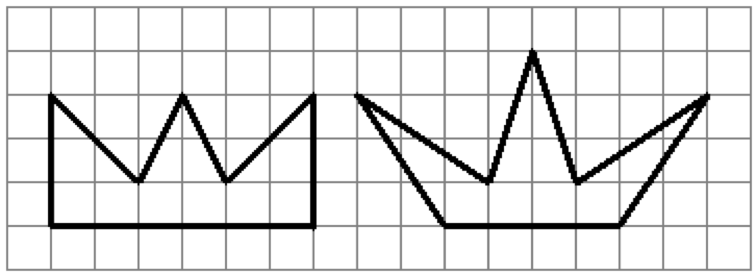Problems
A square napkin was folded in half, the resulting rectangle was then folded in half again (see the figure). The resulting square was then cut with scissors (in a straight line). Could the napkin have been broken up a) into 2 parts? b) into 3 parts? c) into 4 parts? d) into 5 parts? If yes – illustrate such a cut, if not – write the word “no”.
A rabbit, preparing for the arrival of guests, hung lightbulbs in three corners of his polygonal hole. Winnie the Pooh and Piglet came and noticed that lights did not illuminate all the pots of honey which were in the rabbit hole. When they reached for some honey, two of the lightbulbs broke. The rabbit moved the remaining light bulb into some corner so that the whole hole was lit up. Is this possible? (If yes, draw an example, if not, justify the answer.)
The number \(A\) is positive, \(B\) is negative, and \(C\) is zero. What is the sign of the number \(AB + AC + BC\)?
Find the area of the figures shown below.

Ben and Joe play chess. In addition to a chessboard, they have one rook, which they put in the lower right corner, and they move it in turns. It can only be moved upwards or to the left (for any number of cells). The player who can not make a move, loses. Joe goes first. Who will win with the correct method?
Prove that if 21 people collected 200 nuts between them, there are two people in the group who collected the same number of nuts.
There are \(n\) integers. Prove that among them either there are several numbers whose sum is divisible by \(n\) or there is one number divisible by \(n\) itself.
In Mongolia there are in circulation coins of 3 and 5 tugriks. An entrance ticket to the central park costs 4 tugriks. One day before the opening of the park, a line of 200 visitors queued up in front of the ticket booth. Each of them, as well as the cashier, has exactly 22 tugriks. Prove that all of the visitors will be able to buy a ticket in the order of the queue.
There is a rectangular table. Two players start in turn to place on it one pound coin each, so that these coins do not overlap one another. The player who cannot make a move loses. Who will win with the correct strategy?
a) Two players play in the following game: on the table there are 7 two pound coins and 7 one pound coins. In a turn it is allowed to take coins worth no more than three pounds. The one who takes the last coin wins. Who will win with the correct strategy?
b) The same question, if there are 12 one pound and 12 two pound coins.